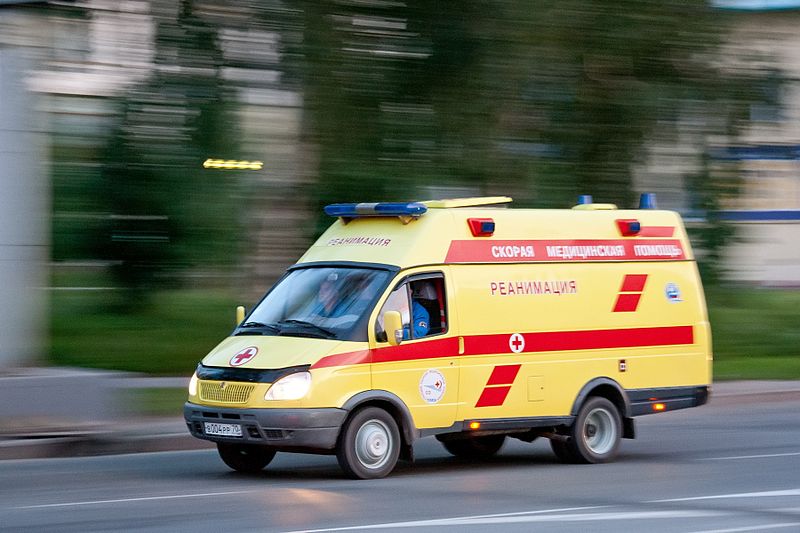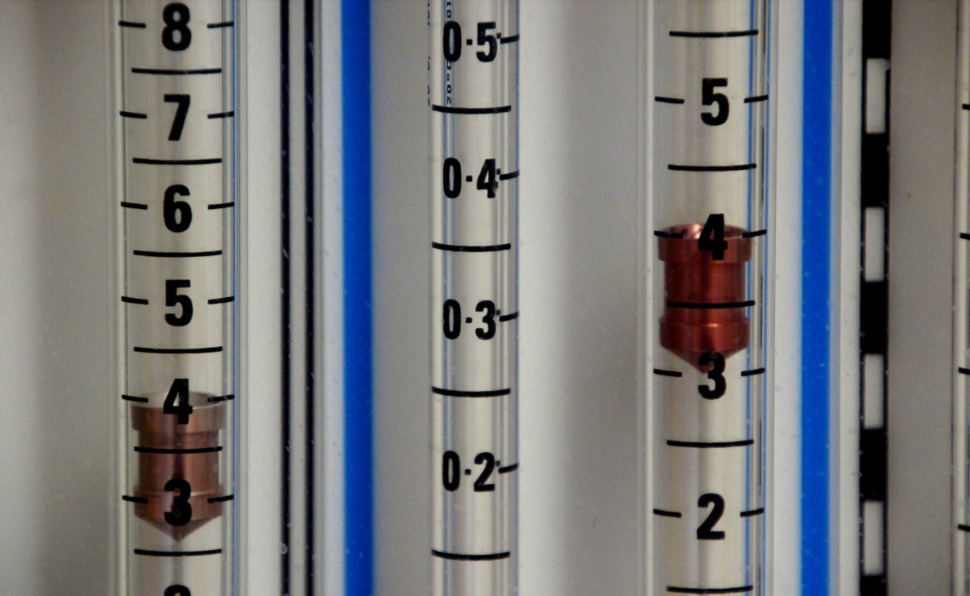Nobody likes to get sick. And it is especially alarming to get sick now, against the backdrop of the coronavirus pandemic and information about thousands of cases. However, we are lucky to live in an age when high technologies penetrated deeply into all spheres of life, not bypassing medicine.
And if you are unlucky enough to get sick or you need surgery, be sure that this will not do without high technology. One of the most important devices for treatment is anesthesia and respiratory apparatus. Not a single operation can do without it now.
This is a technically complex device that requires qualified installation, maintenance, supply of consumables. The personnel working on these devices are also subject to increased requirements. The course of the operation, and often the life of the patient, depends on the competent actions of the anesthesiologist.
What is an anesthesia-respiratory apparatus? (in the documentation, the abbreviation "NDA" is often used, further in the text it will be periodically encountered).
Content
- 1 The device and principle of operation of the NDA
- 2 Other characteristics of OVER
- 3 Number and types of gases used
- 4 NDA modules
- 5 Where and when are anesthesia machines used?
- 6 What to look for when buying an anesthesia and respiratory device?
- 7 Special types of NDA
- 8 Best Anesthesia and Respiratory Devices for 2020
The device and principle of operation of the NDA
Anesthetic and respiratory apparatus - a device for providing anesthesia with liquid and gaseous anesthetics. In addition to anesthesia, the device provides artificial ventilation of the lungs, monitoring of the patient's vital signs. Deep anesthesia relaxes the intercostal muscles and spontaneous breathing may stop. Therefore, simultaneously with the introduction of anesthetic, the device delivers a gas mixture to the lungs for breathing. At the same time, the elimination (removal) of carbon dioxide is ensured, which the patient is also unable to exhale under deep anesthesia. Special sensors track the required volume of the mixture, the frequency of inspiration, indicators of blood oxygen saturation and other vital parameters.
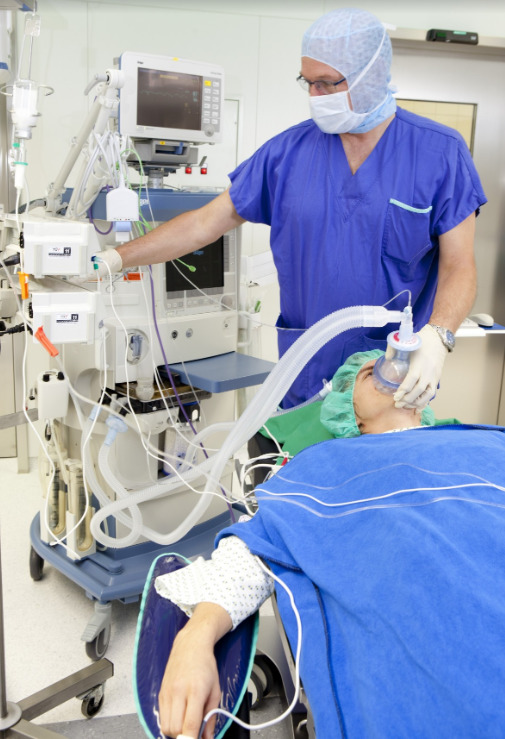
Anesthetic and respiratory apparatus consists of the following main components:
- Gas source (oxygen, nitrous oxide, etc.).
- Vaporizers of liquid narcotic substances (fluorothane, sodium thiopental, sodium oxybate, diethyl ether).
- Dosimeters. Designed for precise regulation of the composition of the gas mixture supplied to the patient. Gas and substance from the evaporator enter the chamber of the rotametric dosimeter, where they are mixed and supplied to the breathing circuit.
- Respiratory circuit. Provides delivery of anesthesia and breathing gas to the patient's lungs. Also responsible for the removal of carbon dioxide.
Gas cylinders and liquid narcotic drugs, pre-connected to the vaporizer, are attached to the device.
When switched on, pressure is created in the system, which directs the gas mixture into the breathing circuit through the reducers.
The respiratory circuit is perhaps the most difficult and responsible part of the NAD, the delivery of anesthesia and ventilation of the patient's lungs depends on its uninterrupted operation.
There are two types of work by type: reversible and non-reversible.
- Reversible
The reversible circuit means that the patient completely inhales the air mixture and the anesthetic that was previously exhaled by him. When using a reversible circuit, the consumption of anesthetic is reduced, and it excludes its entry into the operating room atmosphere and negative impact on medical personnel.
The reversible circuit is divided into closed and semi-closed.
In the closed type, the breathing mixture is completely inhaled by the patient, the exhaled products and water vapor are then discharged into the adsorber and absorbed without entering the surrounding atmosphere.
In the semi-closed type, the mixture is obtained in the same way with the closed type, while part of the exhalation occurs into the atmosphere through the valve, the rest is directed to the system for absorption and removal of moisture, and goes back to the circuit.
- Irreversible
The non-reversible circuit provides that the patient receives an air mixture and anesthetics from a balloon or atmospheric air (using a breathing bag or mask).
The exhalation is carried out into the surrounding atmosphere. This method requires a less complex loop design, indispensable in conditions where small dimensions and deployment speed are important, as well as in the field.
However, it has several drawbacks: increased consumption of anesthesia, contamination of the operating room with vapors of narcotic substances, increased temperature and humidity in the room.
By type, it is also subdivided into open and semi-open.
In an open circuit, the patient receives the anesthetic and the air mixture from the air. A respirator or mask is usually used for anesthesia. This is the simplest method, easily implemented in the field.
Advantages:
- Simplicity, minimal breathing resistance;
Disadvantages:
- Difficulty in exact dosage of the anesthetic;
- The impossibility of simultaneous ventilation;
- Air pollution with anesthetic vapors and increased humidity.
In a half-open circuit, the patient receives anesthetics and breathing mixture from balloons and evaporators through a rotameter. In this case, exhalation occurs into the atmosphere.
Advantages:
- Possibility of accurate dosage of anesthetic;
- Possibility of simultaneous mechanical ventilation;
The disadvantages are the same as in an open system - contamination of the surrounding space with anesthetic vapors, increased humidity, increased consumption of gases and other substances.
Other characteristics of OVER
Number and types of gases used
The overwhelming majority of devices use two gases - oxygen and nitrous oxide. There are also devices where, in addition to the first two, xenon is added, which is used as an anesthetic.
By design of the anesthetic ventilator
- Electric fan;
- Pneumatic fan.
By size
Wall mounted
Compact models designed for use in confined spaces. Such devices are used to equip resuscitation and ambulance cars, ambulances. They are powered by the on-board network, but there are models equipped with batteries to increase autonomy.
Portable
Devices of reduced size, which, if necessary, can be easily moved to the patient. They have simplified functionality. Their main task is to provide emergency care and stabilize the patient's condition before arriving at the stationary point. This technique is in service with emergency services and rescuers. It is additionally equipped with batteries for autonomous operation.
Floor standing
Most technically advanced devices with an extended range of functions, usually with a closed breathing circuit and modular expansion. For ease of movement, they are installed on wheels. After moving to the workplace, the wheels are fixed.
NDA modules
Allow, if necessary, to expand the functionality of the device.
The modules include enlarged reservoirs for gases, a system for monitoring vital parameters of the patient, information modules that allow NAD to be included in the general information system of a medical institution, various sensors that signal changes in patient indicators.
Where and when are anesthesia machines used?
- When performing a surgical intervention.
- With all sorts of severe pathologies - malfunctions of the respiratory tract, heart failure, asthma attacks, pneumonia, pulmonary edema, renal failure.
- For severe poisoning, botulism.
- With extensive burns.
- In cases where the patient is in a coma, with convulsive conditions of various origins, if the patient is in shock.
- When carrying out resuscitation of newborns. To work with small patients, specialized NAD is used - neonatal, designed taking into account the requirements for newborns and infants.
All anesthesia and mechanical ventilation devices are subject to mandatory certification.
What to look for when buying an anesthesia and respiratory device?
First of all, the type of work for which it will be used. If the main purpose is anesthesia and maintenance of vital parameters during operations, special attention should be paid to the amount and type of gases used and the type of breathing circuit used.
For resuscitation, ventilation functionality and monitoring of vital signs are of decisive importance.
Institutional equipment compatibility. It is wise to use one brand for better compatibility between modules. In addition, many manufacturers offer specialized software for integrating equipment into a single information network. This makes it easier to keep track of medical records, track drug consumption and plan interactions between services.
Consumables used.
This includes gases, liquid drugs, adsorbers, spare parts and consumables for the breathing circuit.
Before purchasing equipment, it is extremely important to analyze the needs of the institution, determine the main tasks of use, provide for the scalability of the complex and integration into the technical base already available in the medical institution.
Special types of NDA
For use with MRI
Designed specifically for use in high-intensity electromagnetic environments.
For xenon anesthesia
Xenon is an inert gas that has been used for about 10 years as an anesthetic mixed with oxygen. Its distinctive feature is a low toxic effect on the patient's body. Another feature is the high cost. Devices designed for the use of xenon use a closed or semi-closed loop and a special adsorption system.
Best Anesthesia and Respiratory Devices for 2020
Stationary
CHIRANA VENAR TS + AGAS
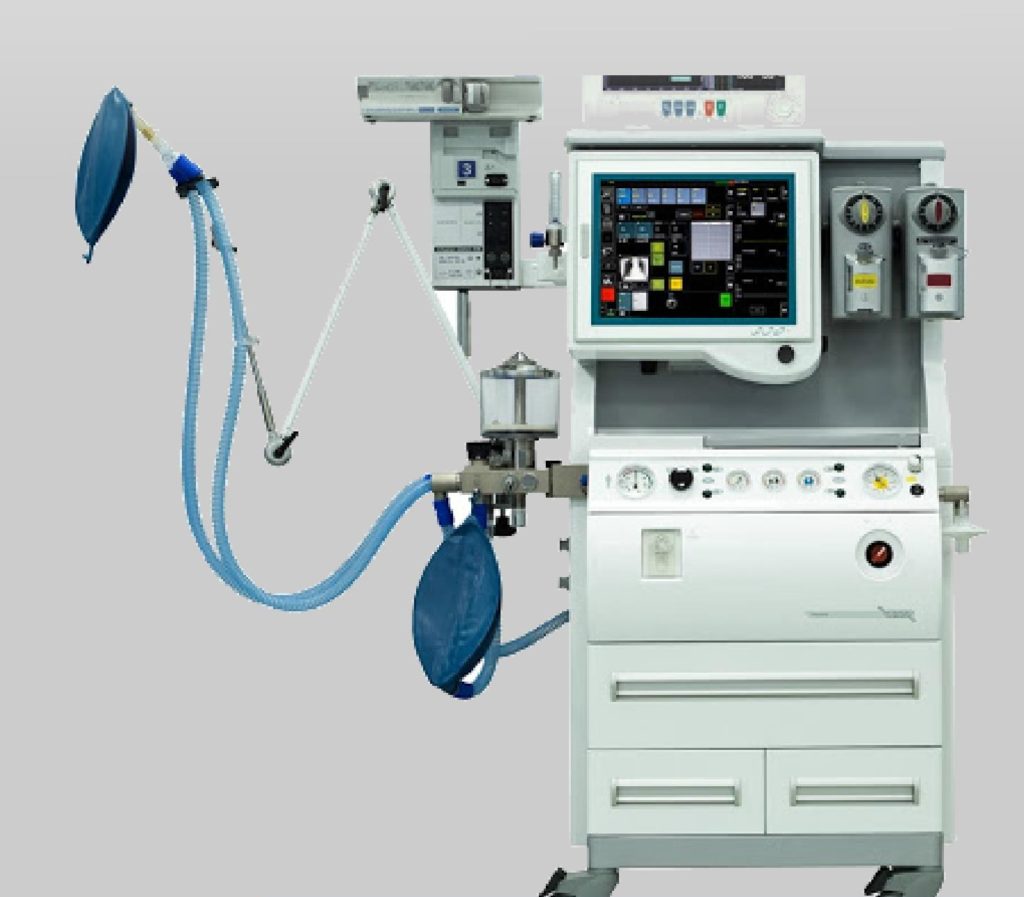
Manufacturer from Eastern Europe. The title reads "Hirana". The company was founded in 1935 in the Slovak Republic. The company specializes in medical equipment for anesthesiology and resuscitation. The company's products are in demand on the domestic market in Slovakia and the countries of the former Warsaw bloc.
It is well known in Russia as well. For the first time, CHIRANA medical equipment appeared in hospitals back in the 50s of the last century, during the Soviet era. The equipment has established itself as reliable and unpretentious in maintenance. CHIRANA NDAs of the ANEMAT series, widely used in medical institutions, are now morally obsolete, therefore the company has replaced them with the VENAR series.
VENAR TS + AGAS - stationary anesthesia and respiratory apparatus.
Fully loaded weight: 130 kg.
The device is equipped with a color touch screen. Three graphs can be displayed simultaneously on the screen:
- Respiratory volume / time;
- Pressure / time;
- Stream / time.
In addition to graphs, you can display graphic loops on the monitor:
- Flow / tidal volume;
- Respiratory volume / pressure.
Monitoring of all parameters of ventilation and respiratory mechanics is provided as standard.
Built-in electronic rotameter.
Electric fan, membrane type. The use of an electrically driven fan eliminates the need for compressed air.In addition, the mechanism is silent in operation.
Venar is designed to work with the inhalational anesthetics Desflurane, Sevoflurane, Isoflurane, Halothane.
Work with half-open, half-closed and closed contours is supported.
Additional equipment features:
- Heating the patient's breathing circuit (helps prevent condensation);
- Active system for removing gases from the breathing circuit;
- Built-in bronchodilator (for aspiration of secretions during patient intubation);
- Possibility of attaching additional modules (monitors, anesthesia depth control systems with graphic display, infusion station);
- Protection against hypoxia;
- Intelligent system for maintaining the overall flow of gases and setting the exact percentage of oxygen in the mixture.
Advantages:
- Low price;
- Modular design;
- Electromechanical fan.
Disadvantages:
- Not identified.
Dräger Fabius MRI
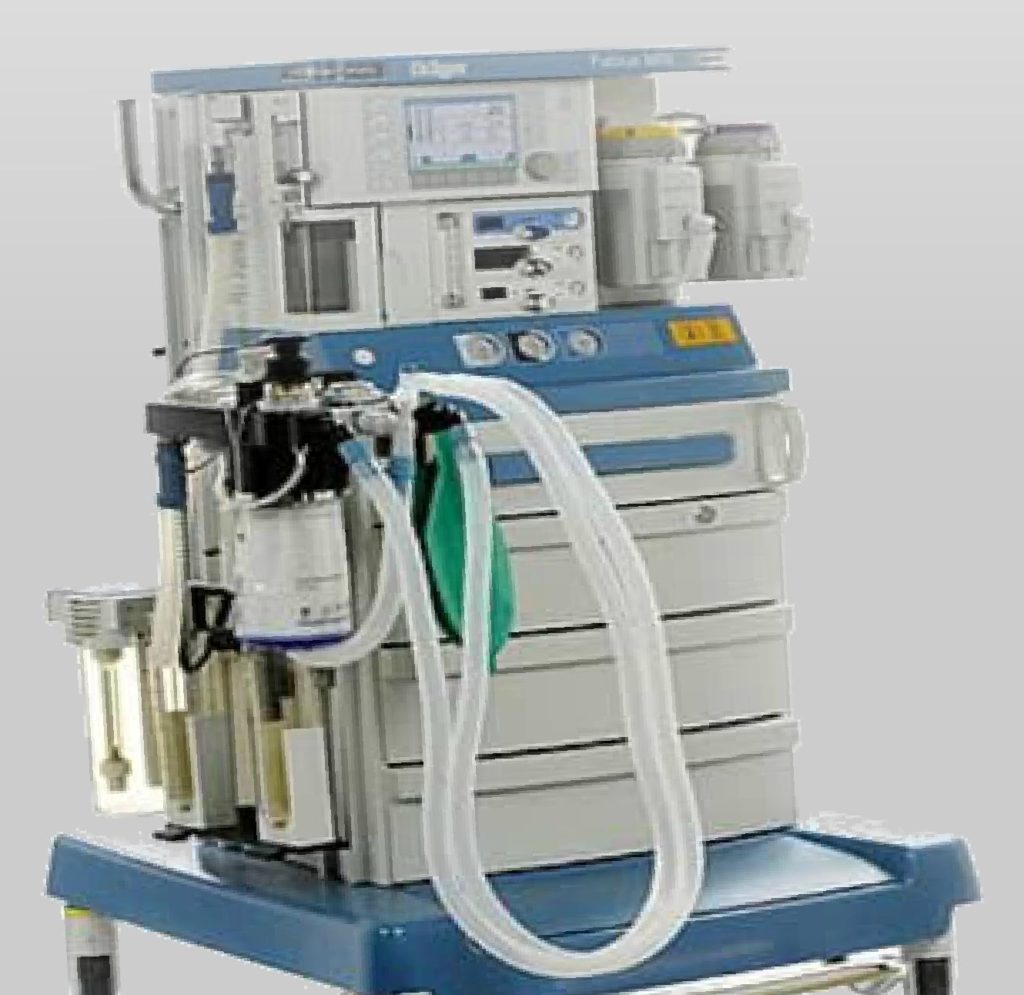
Manufacturer from Germany. One of the leaders in the production of medical equipment. The company offers a wide range of solutions for equipping medical institutions.
The Dräger Fabius MRI is specially designed to work in conjunction with magnetic resonance imaging machines. The device can operate in rooms with scanners up to 3 Tesla.
A reciprocating electric fan is used to supply gases, thus eliminating the need for compressed air to create pressure.
The spontaneous breathing mode is supported, as well as hybrid modes with ventilation control by volume, pressure, manual ventilation.
Advantages:
- Excellent ergonomics, allows you to change the layout depending on the characteristics of the room;
- High equipment reliability;
- Stable operation in magnetic fields.
Disadvantages:
- High price.
PHILIPS Dameca MRI 508
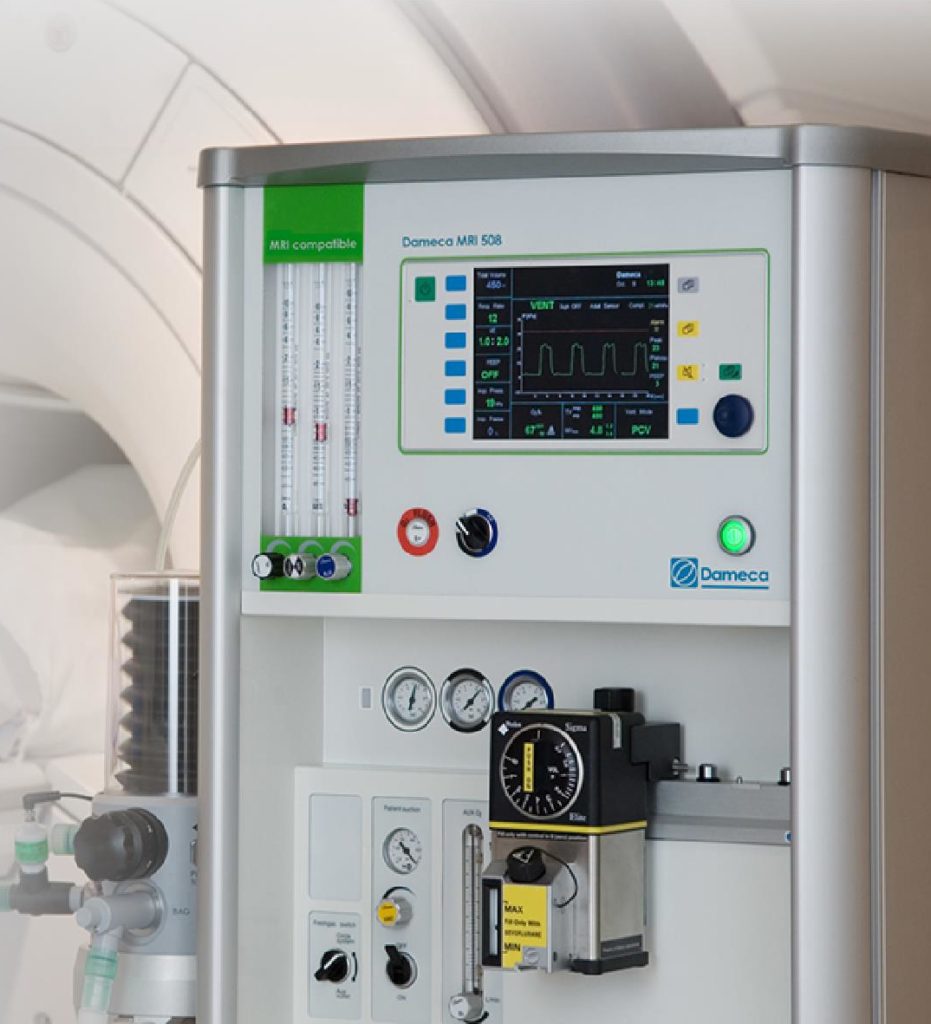
Another NDA capable of working in conjunction with tomographs. PHILIPS Corporation also manufactures MRI machines. The company's engineers are well aware of the difficulties that can arise when using equipment in conditions of high magnetic fields, and they design their equipment taking into account difficult working conditions.
Dameca MRI 508 is designed to work with liquid anesthetics and two types of gas.
The built-in ventilator provides seven ventilation modes, including manual mode and spontaneous breathing mode.
Advantages:
- High equipment reliability;
- Stable operation in magnetic fields.
Disadvantages:
- Not identified.
Dräger Fabius Plus

The next participant in the rating is again the model of the German manufacturer Dräger.
Fabius Plus is a stationary NDA with two containers for gas and two evaporators for anesthetic agent (the manufacturer has provided for the installation of a backup evaporator).
The gas supply is controlled by an electronic fan, no compressed air is required.
As standard, the device can monitor all parameters of ventilation and respiratory mechanics and flexibly control these parameters.
The device operates in a closed, half-open, and half-closed circuit.
A breathing circuit heating is optional.
Batteries are supplied for stand-alone operation with the Fabius Plus. In the absence of power supply, personnel can perform mechanical ventilation in manual mode.
Advantages:
- Flexible layout of modules;
- Connectors for connecting external modules;
- The possibility of autonomous work.
Disadvantages:
- Not identified.
GE Aespire 7100
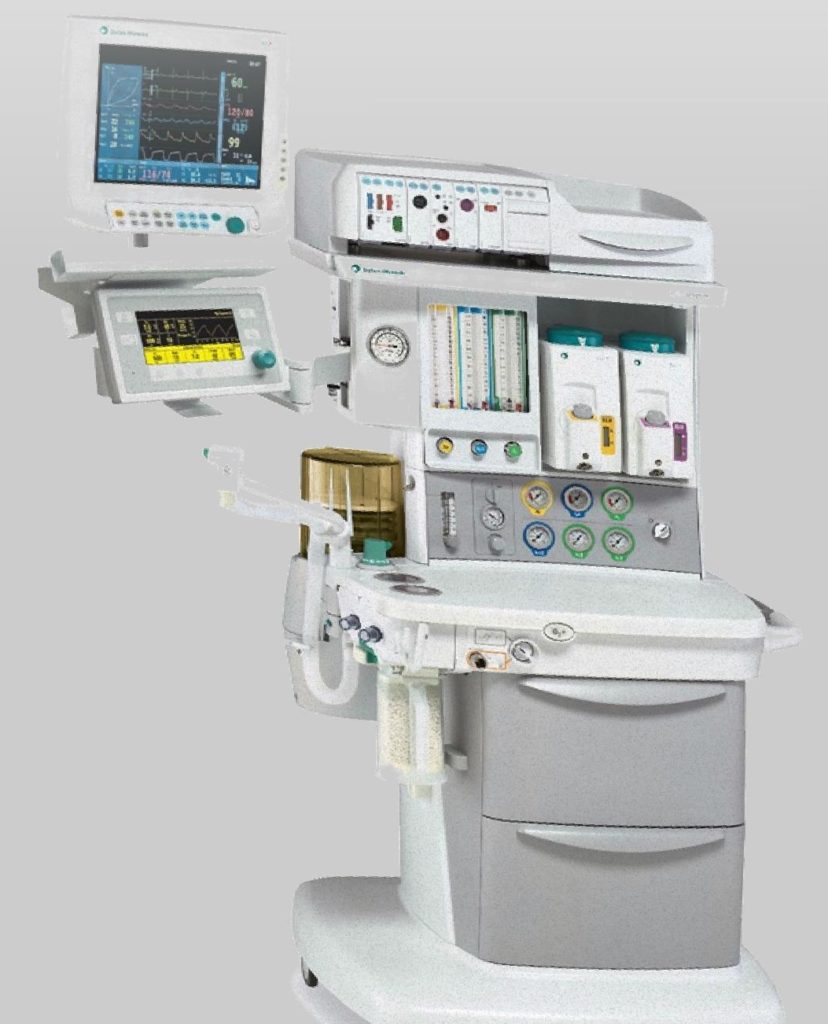
The first line of the rating is occupied by a product of the General Electric concern.
The Aespire 7100 is a compact, full-function OVD with a small working gas volume.
Despite its compact size, the equipment has full performance due to the use of the patented ABS system. Convenience of staff quick replacement of containers is provided, which does not require special tools.
The unit operates in closed, half-open and half-closed circuits.To operate in a closed circuit mode, a bronchodilator and an absorber with the possibility of quick replacement are included as standard.
Three graphs are displayed on the monitor:
- Pressure / time;
- Respiratory volume / time;
- Stream / time.
The modular design is convenient for connecting additional modules, patient monitoring systems, sensors and integration into the information network of a medical institution.
Advantages:
- Compact dimensions;
- Modular design.
Disadvantages:
- High price;
- Low prevalence in institutions, difficulty in integrating with third-party equipment;
- Low system autonomy.
Portable
VEGA-2 (AB)
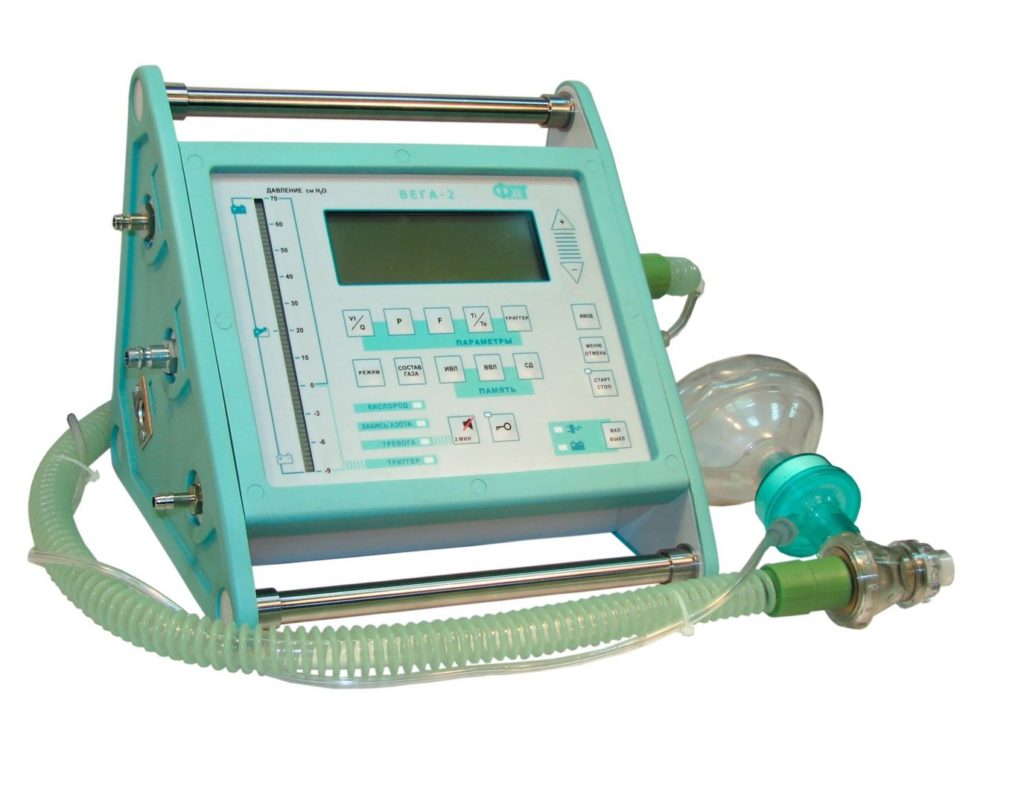
Portable NDA, widely used by ambulance and emergency crews.
During operation, two gases are used - oxygen and nitrous oxide. To reduce the dimensions, the cylinder mount is installed separately. The manufacturer provides for the attachment of the apparatus and gas containers on a stretcher. Attachments to various vertical and horizontal surfaces are also provided.
The supply of anesthetic and mechanical ventilation is carried out in half-open and half-closed breathing circuits.
The device is powered from the on-board network of the vehicle, or by means of batteries. Battery life up to 8 hours, depending on battery condition and temperature conditions.
Advantages:
- Sophisticated mounting system;
- Long battery life;
- Large selection of ventilation modes in ventilation mode.
Disadvantages:
- Poorly designed information menu.
VEGA-2-mini
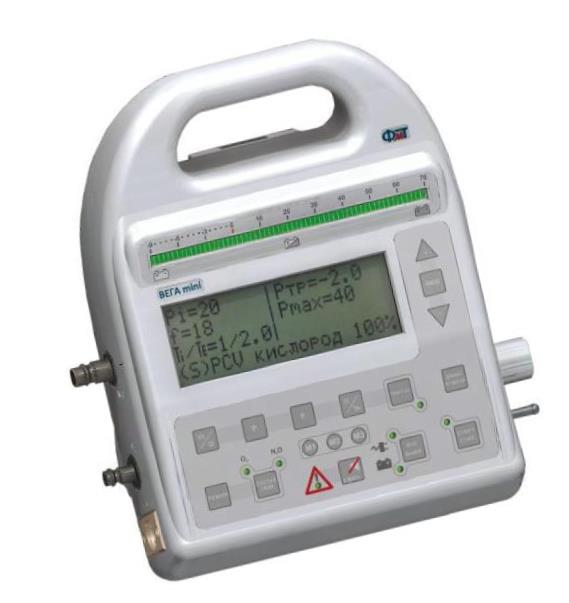
Next in the review is another product of Faktormedtekhnika LLC.
This apparatus is compact and small in size and light in weight (2.5 kg).
The device carries out forced and auxiliary ventilation of the lungs. Supports spontaneous breathing. During mechanical ventilation, pressure and volume are monitored, with data output to the built-in LCD monitor.
The device automatically maintains tidal volume, and has a barotrauma protection mode.
Anesthesia is carried out with nitrous oxide.
Oxygen and anesthetics cylinders are separated from the device and mounted in a special rack. Battery life is 2.5 hours.
Advantages:
- Quick release fasteners;
- Low weight of the device;
- Redesigned firmware interface.
Disadvantages:
- Short battery life;
- No reducer included.
Bahner III

The first place in the rating among mobile solutions is taken by a device from the German concern HEYER.
The mobile anesthesia-breathing apparatus operates with two gases in anesthesia mode; optionally, a third compressed air tank can be connected.
Provides for the supply of anesthetic-respiratory mixture in a semi-closed mode.
This reduces the consumption of gases and anesthetic, and the circulation of air in the circuit allows it to maintain a comfortable temperature and humidity for the patient. This is especially important in the field, because there is no heating of the breathing circuit due to space and battery resources.
The use of halothane, sevoflurane, desflurane is provided as anesthetics.
The device meets all safety standards and requirements, has a built-in blocking of nitrous oxide when the oxygen level decreases.
Bahner III is widely used in hospitals, mobile hospitals, emergency services.
If necessary, the equipment can be installed in a mobile rack, or transported in a case.
The weight of the equipment, depending on the modification, is from 6.2 to 7.9 kg.
Advantages:
- High equipment reliability;
- Convenient monitoring system;
- Possibility of using three gases.
Disadvantages:
- Short battery life;
- Heavy weight for hand carry.
If you have experience in using anesthesia and respiratory devices, write about it in the comments. Be healthy!

